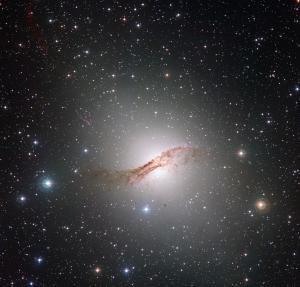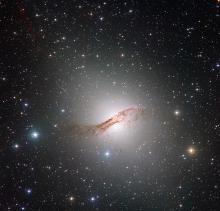Centaurus A [1]
Centaurus A is the fifth-brightest galaxy in the night sky, so it’s an easy target for telescopes and binoculars. But it’s what they can’t see that makes Centaurus A one of the most interesting galaxies around.
Images of the galaxy show a bright blob of stars with wide, dark dust lanes in front of it. That suggests that Centaurus A is the result of a recent merger between two galaxies. New stars are being born in bunches along the dust lanes.
In 1949, radio astronomers found that the galaxy was one of the “loudest” around. The radio waves come from the galaxy’s core and from “jets” that shoot into space above and below the core. They’re almost two million light-years long.
The radio waves are powered by a black hole that’s probably about 55 million times the mass of the Sun. Gas is funneled toward the black hole, perhaps as a result of the merger. As it spirals toward the black hole, it’s heated to millions of degrees. That rips atoms apart, giving them an electric charge. Powerful magnetic fields around the black hole then fling some of the particles out into space, causing them to emit radio waves.
As seen from the United States, Centaurus A stands almost due south as night falls now. It’s best viewed from south of about Dallas or Albuquerque, where it stands a little higher in the sky. Through binoculars, the galaxy looks like a hazy patch of light. It’s just a few degrees above Omega Centauri, a bright star cluster. More about that tomorrow.
Script by Damond Benningfield


